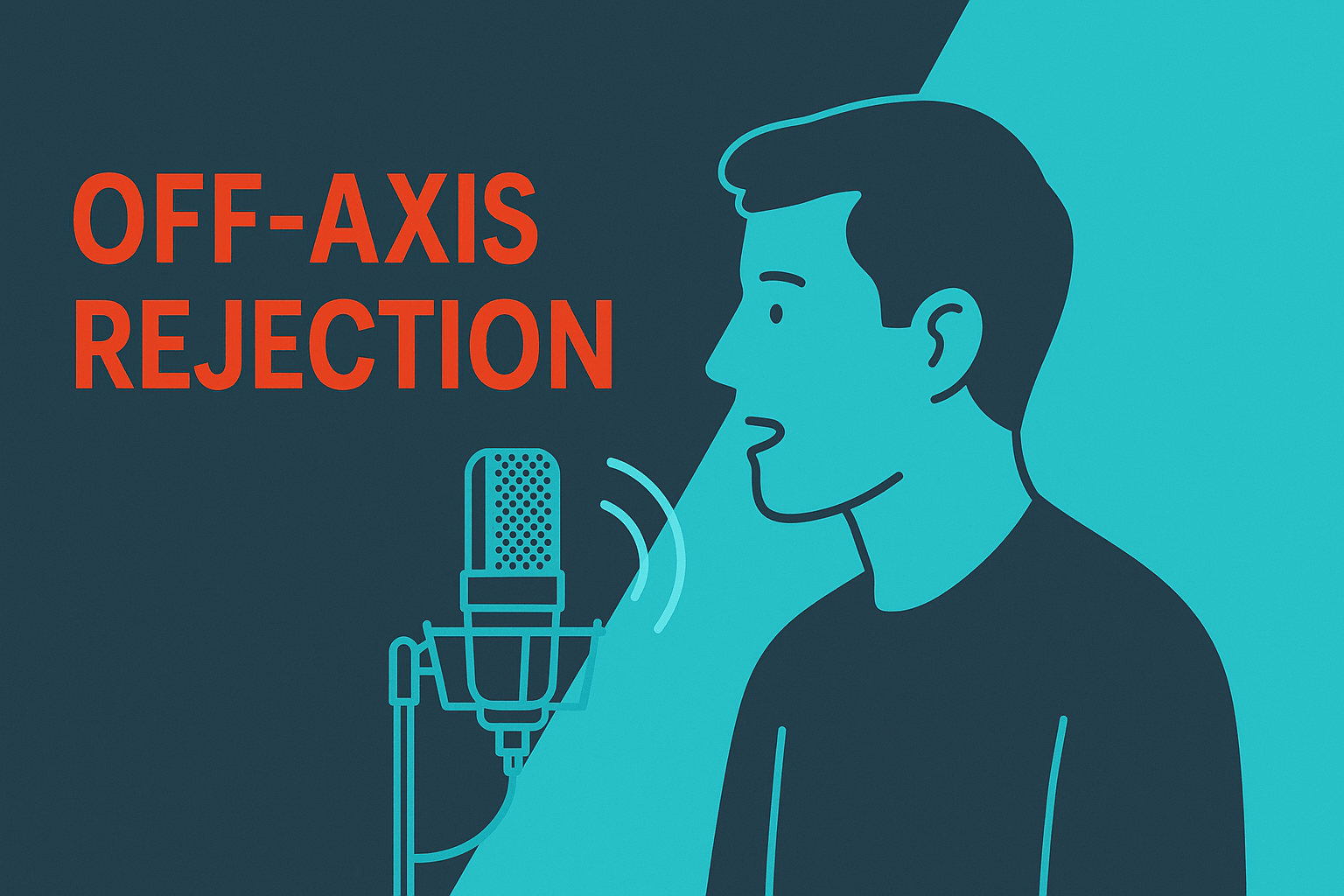If you’re just getting into audio recording, you’ve probably seen terms like “polar pattern” or “off-axis rejection” thrown around. And while they might sound a little technical at first, understanding off-axis rejection is actually one of the easiest ways to instantly improve your recordings—whether you’re podcasting in your bedroom, recording vocals in a home studio, or setting up mics for a live event.
Let’s break it all down in plain English.
What Is Off-Axis Rejection—and Why Should You Care?
Off-axis rejection is how well a microphone blocks out sound that isn’t coming from directly in front of it. Picture this: you’re recording someone talking, but there’s a fan humming in the background or a dog barking down the hall. A mic with good off-axis rejection will focus on your speaker’s voice and reject the unwanted noise from other angles.
This matters because the cleaner your recording, the less work you’ll have to do later when editing or mixing. And if you’re live streaming or recording something you can’t redo—like a podcast or a performance—off-axis rejection can seriously save the day.
Understanding Off-Axis Rejection
What is Off-Axis Sound?
When we say “off-axis,” we’re just talking about sound that hits the mic from the sides or back—not the front. Most of the time, that off-axis sound is background noise you don’t want in your recording.
How Microphones Capture Sound from Different Angles
Every mic has what’s called a polar pattern—a kind of invisible shape around it that shows where it’s most sensitive to sound.
- Cardioid mics, for example, are most sensitive in the front and reject sound from the sides and rear.
- Omnidirectional mics pick up sound equally from all directions.
- Supercardioid and hypercardioid mics have even tighter front focus, with a bit more sensitivity behind them.
Knowing how your mic behaves at different angles is key to using off-axis rejection to your advantage.
The Technical Side (But Don’t Worry—We’ll Keep It Simple)
How Do Mics Reject Off-Axis Sound?
It comes down to microphone design. The internal components—like the diaphragm and acoustic chambers—are shaped in ways that make them less sensitive to certain angles of incoming sound.
Frequency Response and Angle
Here’s a cool thing: most mics don’t just reject all sound equally from off-axis angles—they reject certain frequencies more than others. That means you might still hear some high-pitched or low-pitched noise depending on how your mic is built.
Direct vs. Indirect Sound Waves
Imagine someone speaking directly into the mic—those are direct sound waves. Now picture that same person talking, but you’re hearing their voice reflected off the wall—those are indirect sound waves. A mic with strong off-axis rejection helps reduce those reflections so your recording stays crisp and focused.
What This Means for Your Recordings
Better Sound Quality
Using a mic with good off-axis rejection means you’re capturing only the sound you want—like vocals or an instrument—and keeping background noise out of the mix.
Built-In Noise Control
Even in noisy environments, off-axis rejection acts like a built-in filter. No fancy editing tricks needed—your mic is already doing part of the job for you.
Works in Any Setting
Whether you’re recording in a bedroom studio, a podcast booth, or on a stage, good off-axis rejection helps you control your sound environment.
Real-World Examples: Where Off-Axis Rejection Matters
Studio Sessions
Let’s say you’re recording vocals, and the singer is in the same room as the producer clicking a mouse or giving direction. A cardioid mic helps isolate the voice and push everything else into the background.
Live Performances
On stage, you’ve got amps, drums, crowd noise—it’s chaos. A mic with strong off-axis rejection makes sure only the performer’s voice or instrument is front and center in the mix.
Podcasts and Broadcasting
Got a noisy air conditioner? Recording near a window facing the street? A directional mic helps you sound clean and professional, even if your environment isn’t ideal.
How to Choose the Right Mic for Off-Axis Rejection
What to Look For
- A tight polar pattern (like supercardioid or hypercardioid)
- Good side and rear rejection in spec sheets or reviews
- A flat or controlled frequency response off-axis (you can find this in detailed mic charts)
Mic Type Comparison
- Dynamic mics usually offer stronger rejection and are great for loud environments.
- Condenser mics are more sensitive but can still offer good rejection depending on the design.
Match the Mic to Your Needs
- For studio vocals: a large-diaphragm cardioid condenser often works great.
- For podcasting: dynamic mics like the Shure SM7B or Rode PodMic shine with their rejection abilities.
- For live gigs: go for a supercardioid dynamic like the Sennheiser e945 or the Shure Beta 58A.
Wrapping It Up
Off-axis rejection might not be the flashiest spec on a mic box, but it’s one of the most powerful tools for clean, professional-sounding recordings. Whether you’re battling background noise, room reflections, or just trying to keep your mix clear, choosing the right mic—and using it properly—can make a huge difference.
And as mic technology keeps improving, we’re likely to see even smarter designs that give you better rejection and cleaner sound, without needing a treated studio or expensive gear.
Want to level up your recordings without spending hours editing? Start with the mic—and make sure off-axis rejection is on your radar.
Need help choosing the right mic for your setup? Drop a comment or check out our mic buying guides to find the best fit for your sound.

Leave a Reply